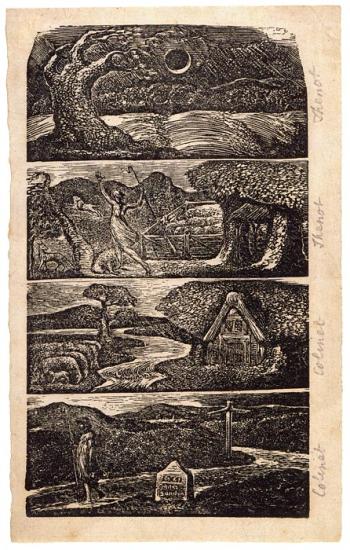Four wood engravings

Four wood engravings printed from one block for The Pastorals of Virgil, adapted by Robert John Thornton.
London: J. McGowan for Rivington [and others], 1821.
Purchased by Pierpont Morgan in 1906
In about 1820 Blake designed seventeen small wood engravings for a textbook translation of Virgil. He engraved all but three of them himself as well as six copperplate images. A new medium for Blake, the small wood engravings were highly esteemed by the Ancients, especially Edward Calvert, several of whose small pastoral images appear in this case.
In 1825 John Linnell had purchased Blake's wood blocks (for 2 guineas) and had them printed by Calvert. Linnell and his family continued to publish them occasionally into the middle of the nineteenth century. The blocks were acquired by the British Museum in 1939.
William Blake (1757–1827) occupies a unique place in the history of Western art. His creativity included both the visual and literary arts. In his lifetime he was best known as an engraver; now he is also recognized for his innovative poetry, printmaking, and painting. Blake's keen perception of the political and social climate found expression throughout his work. His strong sense of independence is evident in the complex mythology that he constructed in response to the age of revolution.
Blake was already recognized as an engraver at age twenty-five, when his first volume of poems appeared. At thirty-three, in The Marriage of Heaven and Hell, he audaciously claimed that his birth had marked the origin of a "new heaven" in which his own art would exemplify the creativity prefigured by Milton and Michelangelo. By that time, Blake, in one of his most productive periods, had already produced Songs of Innocence and was at work on a series of illuminated books. In 1818 he met John Linnell, a young painter and engraver, through whom a group of young artists became Blake's followers. Calling themselves the Ancients, they helped perpetuate Blake's influence for generations.
The Morgan's Blake collection—one of this country's most distinguished—began with purchases as early as 1899 by Pierpont Morgan. During the tenure of Charles Ryskamp, director from 1969 to 1986, major gifts almost doubled the size of its Blake holdings. In recent years Ryskamp's own gifts of engravings, letters, and related materials have significantly enriched its scholarly resources.
This online exhibition is presented in conjunction with the exhibition William Blake's World: "A New Heaven Is Begun" on view September 11, 2009, through January 3, 2010.
This exhibition is made possible through the generosity of Fay and Geoffrey Elliott.